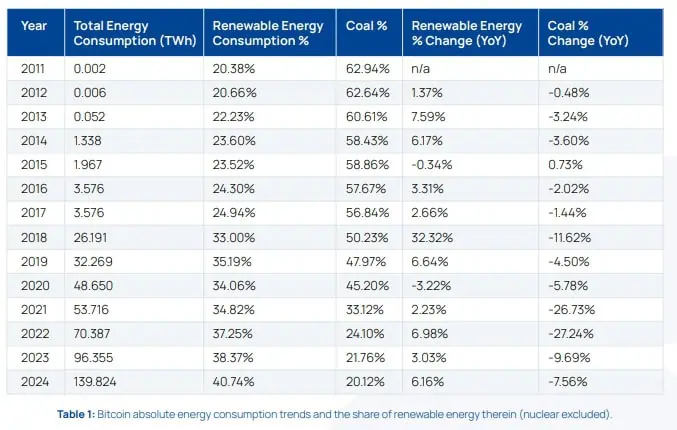
Bitcoin mining, known for its high energy consumption, is undergoing a significant transformation toward sustainability.
A recent report, prepared by MiCA Crypto Alliance and Nodiens, reveals how the adoption of renewable energy is revolutionizing the sector, reducing its carbon footprint and promoting energy innovation.
Bitcoin mining, which is critical to maintaining the security and operation of the blockchain network, has been the subject of debate for years due to its energy consumption. However, as highlighted in the report titled “Mining the Future: Bitcoin's Carbon Footprint and the Path to 2030”The industry has undergone a remarkable evolution. According to the MiCA Crypto Alliance and Nodiens, network miners are adopting renewable energy at an accelerated pace.
Between 2011 and 2024, The share of renewable energy in Bitcoin's energy mix increased from 20% to 41%.While Coal use was reduced from 63% to 20%Furthermore, it is projected that by 2030, at least 70% of the energy used by the Bitcoin network will come from sustainable sources.
Researchers have highlighted that this change is not only beneficial for the Bitcoin network and the environment, but is also driving innovation in the energy sector and could influence other industries to follow suit and move toward greater sustainability.
The transition from Bitcoin mining to renewable energy
Bitcoin mining, which uses the Proof of Work (PoW) consensus mechanism, requires a large amount of energy to maintain its security and operation. Historically, this energy came largely from fossil fuels, raising concerns about its carbon footprint. However, in recent years, the industry has undergone a complete transformation.
According to the aforementioned report, the share of renewable energy in Bitcoin's energy mix has increased significantly. Currently, 41% of the network's energy comes from renewable sources, while the use of coal-fired energy has decreased dramatically.

Source: MiCA Crypto Alliance and Nodiens
This transition to clean energy is due to several factors, including the increasing availability of renewable energy technologies, government policies that encourage the transition to clean sources and the very economy of crypto mining, which is driving miners to seek more accessible and sustainable energy sources.
BUY BITCOINThe report also noted that, in 2024, 1,08% of the energy used by Bitcoin came from natural gas venting, a practice that is helping to reduce dependence on traditional fossil fuels and is contributing to mitigating the environmental impact of methane emissions.
Furthermore, the report predicts that by 2030, the Bitcoin network will be powered by at least 70% sustainable energy sources. If this trend continues, Bitcoin mining will not only reduce its carbon footprint but also become a model for other industries to follow.
Bitcoin mining advances energy innovation
The adoption of renewable energy by Bitcoin mining has not only reduced the network's potential environmental impact, but has also spurred innovation in the energy sector. Miners have begun exploring new ways to harness clean energy sources, such as solar, wind, and hydroelectric power, and implementing more efficient technologies to reduce their consumption.
A notable example of this transformation has been the use of waste energy, such as methane gas burned in oil wells, to power miners. This practice has not only prevented methane, a potent greenhouse gas, from being released into the atmosphere, but has also generated electricity useful for cryptocurrency mining in a novel way.
PREPARE YOUR WALLETIn addition, Bitcoin mining is promoting the creation of local renewable energy markets in remote regions, where surplus energy generation can be used to power mining centers. For example, in Japan, the Tokyo Electric Power Company has launched a plan to Use the country's surplus electricity to mine bitcoins, boosting the local economy and encouraging the adoption of clean technologies.
The MiCA Crypto Alliance and Nodiens report highlights that the crypto mining trend toward renewable energy is attracting new players to the sector, including companies seeking to reduce their carbon footprint and contribute to the global energy transition.
Bitcoin mining is showing a model for other industries
Bitcoin mining's transition to renewable energy is setting a precedent for other electricity-consuming industries. Crypto mining is an energy-intensive activity, so its shift to sustainable sources demonstrates how sectors can adapt to a cleaner model.
The researchers also noted that this shift, in addition to influencing the adoption of clean technologies in other areas, is demonstrating that sustainability can be profitable. As renewable energy becomes more accessible and affordable, Bitcoin miners are finding that reducing their dependence on fossil fuels not only reduces their carbon footprint but also their long-term operating costs.
The report suggests that if other industries follow the example of miners operating on the Bitcoin network, the transition to a more sustainable world could be significantly accelerated.

Bitcoin 101 Course
Medium levelIn Bit101Me Academy's Bitcoin 2 Course you can continue your crypto education and learn what Bitcoin is, where it comes from and how to obtain it.
Stabilization of electrical networks
In addition to accelerating the development of clean energy systems, Bitcoin mining is also making a key contribution to stabilizing power grids. Because it involves a variable load that can be switched on or off based on demand, it is emerging as a useful tool for managing excess renewable energy in times of low demand.
In many regions, such as the U.S. state of Texas, renewable energy sources such as solar and wind generate electricity intermittently. During periods of high generation, such as sunny days or windy nights, power grids can become overloaded. Bitcoin mining can absorb this excess energy, making it a valuable asset for grid operators.
Additionally, during times of high demand, Bitcoin miners may temporarily reduce their activity to free up network capacity and avoid power outages. This flexibility is being recognized as a key advantage in the management of modern energy systems.
Considering its potential advantage, the report argues that if adopted on a large scale, Bitcoin mining could become a fundamental pillar for the energy transition, helping to ensure the stability of electrical grids and promoting the use of renewable energy..
BUY BITCOINIn conclusion, Bitcoin mining, once criticized for its environmental impact, is undergoing a radical transformation toward sustainability. With the increased use of renewable energy and reduced dependence on fossil fuels, this industry is proving that economic and environmental sustainability can go hand in hand. This shift is not only benefiting the planet but also reinforcing Bitcoin's role as a revolutionary technology in the digital age.
Investing in cryptoassets is not fully regulated, may not be suitable for retail investors due to high volatility and there is a risk of losing all invested amounts.



